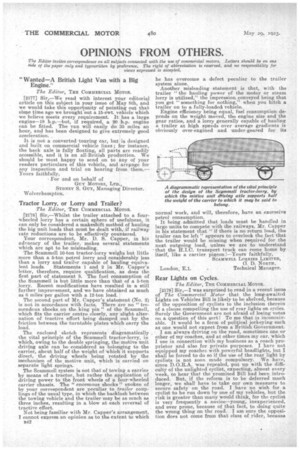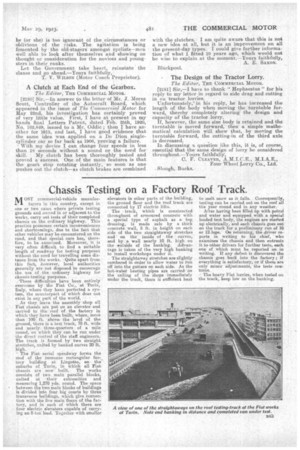OPINIONS FROM OTHERS.
Page 28

Page 29

If you've noticed an error in this article please click here to report it so we can fix it.
The Editor invites correspondence on all subjects connected with the use of commercial victors. Letters should be on one side of the paper only and typewritten by preference, The right of abbreviation is reserved, and no responsibility for views expressed is accepted, " Wanted—A British Light Van with a Big Engine."
The Editor, TEE COMMERCIAL Wiwi.
{21'77] Sir,—We read with interest ydur editorial article on this subject in your issue of May 8th, and we would take this opportunity of pointing out that sbrae time ago we brought outa 15-cwt. vehicle which we believe meets every requirement. It has a large engine-18 hp.—but, if required, a 20 h.p. engine can be fitted. The van will easily do 35 miles an hour, and has been designed to give extremely good acceleration. ; It is not a converted touring car, but is designed and built on commercial vehicle lines ; for instance, the back axle is fully floating, all parts are readily accessible, and it is an all-British production. We should be most happy to send on to any of your readers particulars of this vehicle, and arrange for any inspection and trial on hearing from them.— Yours faithfully,
For and on behalf of
Guy MOTORS, LTD.,
Tractor Lorry, or Lorry and Trailer?
The Editor, THE COMMERCIAL MOTOR.
[2178] Sir,—.Whilst the trailer attached to a fourwheeled lorry has a certain sphere of usefulness, it can only be considered a makeshift method of hauling the big unit loads that must be dealt with, if railway rate reductions are to be effectively countered. Your correspondent, Mr. D. S. Capper, in his advocacy of the trailer, makes several statements which are apt to be misleading.
The Scammell 10-ton tractor-lorry weighs but little more than a 5-ton petrol lorry and considerably less than a lorry and trailer capable of hauling equiva
lent loads. Statements 1 and 2 in Mr. Capper's letter, therefore, require qualification, as does the first part of statement 3. The fuel consumption of the Scammell is but little more than that of a 5-ton lorry. Recent modifications have resulted in a still further improvement, and we have obtained as much as 6 miles per gallon with a 12-ton load.
The second part of Mr. Capper's statement (No. 3) is not in accordance with facts. There are no " tremendous shocks on the king pin" of the Scrimmell, which fits the carrier centre closely, any slight alternation of tractive effort being damped out by the friction between the turntable plates which carry the load.
The enclosed sketch represents diagramatically the vital principle, of the Searnmell tractor-lorry, in which, owing to the double springing, thefl motive unit driving axle can be considered as belonging to the carrier, about half of the weight of -which it supports direct, the driving wheels being rotated by the mechanism of the motive unit, which is carried on separate light springs.
The Searnmell system is not that of towing a carrier by means of a tractor, but rather the application of driving power to the front wheels of a four-wheeled carrier chassis. The " enormous shocks" spoken of by your correspondent are peculiar to trailer couplings of the usual type, in which the backlash between the towing vehicle and the trailer may be as much as three inches, resulting in a blow at each reversal of tractive effort.
Not being familiar with Mr. Capper's arrangement, I cannot express an opinion as to the extent to which 1342 he has overcome a defect peculiar to the trailer system alone. Another misleading statement is that, with the trailer "the hauling power of the motor or steam lorry is utilized," the impression conveyed being that you get "something for nothing," when you hitch a trailer on to a fully-loaded vehicle. Engine effieiency being equal, fuel consumption depends on the weight moved, the engine size and the gear ratios, and a lorry generally capable of hauling a trailer at high speeds over average gradients is obviously aver-engined and under-geared for its normal work, and will, therefore, have an excessive petrol consumption.
It being admitted that loads must be handled in large units to compete with the railways, Mr. Capper in his statement that "if there is no return load, the trailer can be left" appears to overlook the fact•that the trailer would be missing when required for the next outgoing load, unless we are to understand that the 11.I.0. transport truck can come home by itself, like a carrier pigeon i—Yours faithfully, SCAMMELL LORRIES LIMITED,
0. D. NORTE,
London, E.1. Technical Manager.
Rear Lights on Cycles.
The Editor, TEE COMMERCIAL MOTOR.
[21701 Sir,—I was surprised to read in a recent issue of The Commercial Motor that the long-awaited Lights on Vehicles Bill is likely to be. shelved, because of the opposition of cyclists to the inclusion therein of a clause compelling the use of rear lights on cycles. Surely the Government are not afraid of losing votes on a question of this 4ort! To me that is inconceivable. It would be a form of political jockeying such as one would not expect from a British Government. I am always driving on the road, sometimes one or other of my coaches, and at other times my car, which I use in connection with my business as a. coach proprietor and also for private purposes. I have not equipped my coacher with powerful headlights, but. I shall be forced to do so if the use of the rear light by cyclists is not soon made compulsory. -We have, since D.O.R.A. was repealed, put up with the difficulty of the unlighted cyclist, expecting, almost every week, to hear that the promised Bill had been introduced. But, if the reform is to be deferred much longer, we shall have to take our own measures to secure safety on the Toad. I have no wish for a cyclist to be run down by one of my vehicles, but the risk is greater than many would think,. for the cyclist is very frequent3y a novice—young, inexperienced, and ever prone, because of that fact, to doing quite the wrong thing on the road. I am sure the opposition does not come from that class of rider, because
he (or she) is too ignorant of the circumstances or oblivious of the risks. The agitation is being fomented by the old-stagers amongst cyclists—men well able to look after themselves and showing no thought or consideration for the novices and youngsters in their ranks.
Let the Government. take heart, reinstate the clause and go ahead.—Yours faithfully,
T. V. WILSON (Motor Coach Proprietor).
A Clutch at Each End of the Gearbox.
The Editor, THE COMMERCIAL MOTOR.
[2180] Sir,—In answer to the letter of Mr. J. Morse Scott, Controller of the Autocraft Board, which appeared in the issue of The Commercial Motor for May 22nd, his investigation has certainly proved of very little value. First, I have at present in my hands final Letters Patent, dated Feb. 25th, 1920, No. 162,849, issued to a Mr. Oddie ; then I have another for 1915, and last, I have good evidence that the same idea was applied on a De Dion singlecylinder ear so far back as 1906, proving a failure.
With my device I can change four speeds in less than 18 seconds without a sound or the need for skill. My clutch has been thoroughly tested and proved a success. One of the main features is that the gear's stop rotating instantly, so soon as one pushes out the clutch—as clutch brakes are combined with the elutches. I ant quite aware that this is not a new idea at all, but it is an improvement on all the present-day types. I could give further information of what I fitted 10 years ago, which would, not be wise to explain at the monient.—Yours faithfully, A. E. SAXON.
Blackpool.
The Design of the Tractor Lorry.
The Editor, THE COMMERCIAL MOTOR.
[21811 Sir,—I. have to thank " Hephaestus "for his reply to my letter in regard to side drag and cutting in on tractor lorries.
'Unfortunately, in, his reply, he has increased the length of the body when moving the turntable forward, thereby completely altering the design and capacity of the tractor lorry. If, however, the same size body is retained and the turntable is moved forward, then a simple mathematical calculation will show that, by moving the turntable forward, the cutting-in of the third axle is decreased.
In discussing a question like this, it is, of course, essential that the same, design of lorry be considered throughout.—Yours faithfully, C. F. CLEAVER, A. M. I. C. E. , M. I. A. E., Four Wheel Lorry Co., Ltd. . Slough, Bucks.
































